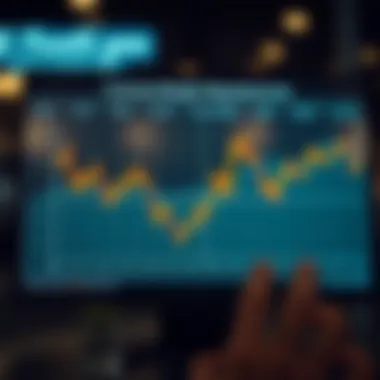Navigating Ironbeam Futures Margin Requirements Effectively


Intro
Futures trading provides investors access to various financial markets, allowing them to hedge risks or speculate on price movements. One key component that can impact traders significantly is margins. In the realm of Ironbeam futures, understanding margins is crucial, whether you are stepping into this market for the first time or have years of experience under your belt. The margin system essentially dictates how much capital you need to put on the table to secure a position in these contracts.
Beneath the flashy exterior of futures trading lurks a complex web of terms and conditions. If you aren't careful, you can land yourself in hot water before you even realize what hit you. This article unpacks the essentials of Ironbeam futures margins, enabling investors to navigate their way through this intricate environment with ease and confidence.
By gaining a thorough understanding of key concepts like margin requirements and leverage, traders will be poised to make informed choices. Additionally, we'll delve into the differences between Ironbeam's approach to margins as opposed to industry standards, offering insights into best practices for successful margin trading.
So, let’s roll up our sleeves and dive deeper into the terms and definitions that separate the novices from the pros in this exciting trading sphere.
Preface to Ironbeam Futures
Understanding how Ironbeam operates within the broader scope of futures trading is crucial for any investor, whether they’re just dipping their toes into the market or are well-versed in trading strategies. This section sheds light on the intricate world of Ironbeam Futures, drawing attention to the broker’s unique attributes and settings that influence trading outcomes.
Definition of Futures Trading
Futures trading encompasses contracts that obligate buyers and sellers to transact an asset at a predetermined price on a specified future date. It's a way for traders to hedge against potential price fluctuations of assets like commodities, currencies, or even financial indices. The allure of futures trading lies not just in its potential for profits, but also in the strategic flexibility it offers investors.
A clever twist with futures is that they often require investors to only put up a fraction of the total value of the contract; this brings us to the concept of margin. Understanding how margins work in futures trading can be the difference between a profitable trade and a costly mistake.
Ironbeam as a Futures Broker
Ironbeam stands out in the crowded field of futures brokers by offering competitive margin rates, advanced trading platforms, and educational resources for traders of all levels. Unlike many brokers that might overwhelm you with complex systems and hidden fees, Ironbeam aims for transparency. This is especially valuable for new traders who might feel daunted by the sheer volume of options and strategies available.
With a user-friendly interface, Ironbeam allows investors to navigate the futures landscape with a sense of ease. Whether you are trading agricultural products, metals, or energies, Ironbeam supports a wide variety of futures, making it an attractive option for those looking to diversify their portfolios.
In summary, grasping the fundamentals of Ironbeam Futures not only helps in maximizing potential returns but also in managing risks effectively. In the next sections, we will delve deeper into the margins associated with futures trading and how they are specifically applied within the Ironbeam framework.
Understanding Margins in Futures Trading
Margins are a cornerstone of futures trading, functioning as a financial safety net for market participants and brokers alike. By grasping the intricacies of margins, both budding and experienced investors can navigate the labyrinth of futures trading with greater confidence. Margins serve as a means to manage risk and maintain liquidity, making them an essential building block within the trading landscape. As the old saying goes, "Don’t put all your eggs in one basket," and margins provide a way to distribute risk more evenly across various positions.
What are Margins?
In the simplest terms, margins represent the amount of money that an investor must deposit with a broker to open a trading position in futures. This amount acts as a performance bond, ensuring that the trader can meet their financial obligations regarding potential losses. Essentially, margins are a way to leverage a smaller investment into a more significant position.
For instance, imagine a trader looking to control a futures contract that has a notional value of $100,000. Instead of needing the entire $100,000 upfront, the broker may only require a margin deposit of $10,000. This leverage can amplify profits but can also magnify losses, which is why understanding margins is paramount.
Types of Margins
Margins come in different forms, each playing a specific role in the trading process. Two primary types are commonly recognized: Initial Margin and Maintenance Margin.
Initial Margin
The initial margin is the upfront amount required to initiate a futures position. It acts as a barrier to entry, ensuring that a trader has sufficient funds to cover their commitment.
One key characteristic of the initial margin is that it is determined by the broker and can vary significantly across different contracts and assets. This margin is vital for maintaining stability in the market and protecting against defaults. It is a beneficial choice for traders since it allows them to control large positions without needing to invest the full amount upfront. However, this leverage can be a double-edged sword, as it can lead to amplified losses if the market moves against the trader.
In this article, the initial margin serves as a crucial lever to understanding how leverage works in futures trading—a vital concept when it comes to executing successful trading strategies.


Maintenance Margin
Once a position is opened, the maintenance margin comes into play. This is the minimum amount a trader must maintain in their margin account to keep their position active. Falling below this level can trigger a margin call, compelling the investor to deposit more funds to cover the position.
The maintenance margin is often lower than the initial margin, which means traders can keep their positions open with less capital as long as market conditions allow. This unique feature can be advantageous for those looking to minimize their upfront costs. However, if market volatility is high and losses begin to accumulate, a trader can quickly find themselves in a precarious position.
Margins in futures trading are not just numbers; they represent a trader’s risk exposure and potential. Keeping a close eye on both initial and maintenance margins is crucial for navigating the often tumultuous waters of futures trading seamlessly. Being aware of your margins might save you from unexpected pitfalls, allowing you to stay afloat and focused on your trading goals.
Understanding margins helps traders maintain better control over their risk profile, which is essential for long-term success in futures trading.
How Ironbeam Determines Margin Requirements
Ironbeam’s approach to setting margin requirements is crucial for both new and experienced traders in the futures market. Understanding this process can greatly influence a trader's strategy and risk management practices. Margin is essentially a security deposit required to enter a position, and how Ironbeam calculates these requirements depends on multiple factors. Knowing these can empower traders to make informed decisions and potentially improve their trading outcomes.
Factors Influencing Margin Rates
Market Volatility
Market volatility is a significant player in determining margin requirements. High volatility often leads to higher margin rates because it indicates greater price risks. Traders need to be aware that when a market reacts dramatically to news or economic indicators, the broker might raise margin levels to protect against potential losses. This proactive measure serves as a cushion during turbulent times.
- Key characteristic: Volatility can fluctuate unpredictably, causing both sudden loss and potentially significant profit opportunities.
- Beneficial for traders: By closely monitoring market conditions, traders can gauge their exposure and adjust their strategies.
- Unique feature: Volatility often results in wider bid-ask spreads, which can impact trading costs and overall profitability during erratic market conditions.
- Advantages: A higher margin requirement in a volatile market means that investors have to put more capital at risk upfront, which may deter reckless trading.
Asset Type
The type of asset being traded also plays a critical role in margin determinations at Ironbeam. Different asset classes, from commodities to currencies, carry varying levels of risk and, consequently, differing margin necessities. Factors such as liquidity, stability, and market prevalence come into play.
- Key characteristic: Certain commodities, like crude oil, are known for their pronounced price swings, often meriting higher margin requirements than stable assets like government bonds.
- Beneficial for traders: Understanding how asset types influence margins allows traders to select assets more strategically based on their risk profile and trading approach.
- Unique feature: Some asset types may require specific allocation strategies for margins, considering their characteristics in fluctuations and how well they perform under various market conditions.
- Advantages: Knowing the asset type can help traders assess risk better and prepare for market interventions, making informed decisions about their margin settings.
Comparison with Competitors
When comparing Ironbeam’s margin structures to those of its competitors, several points of distinction emerge. While many brokers adopt similar formulas, Ironbeam’s policies tend to be more adaptable based on real-time market conditions. Competitive brokers like TD Ameritrade and E*TRADE have their margin rates influenced by similar factors but may feature different risk assessment techniques.
Understanding these differences can reveal opportunities for traders. For instance, some brokers might impose stricter margin levels during turbulent times while Ironbeam might take a more lenient stance, considering their traders’ experience levels. This flexibility allows traders to make choices that best align with their financial capabilities and preferences.
As we move forward, it’s vital for traders to remain proactive in understanding how various elements shape their margin requirements. Being savvy about these factors and contextualizing them within their unique trading strategies can foster better financial outcomes.
Leverage and Risk Management
Leverage and risk management play pivotal roles in the arenas of futures trading, especially when navigating the intricate landscape of Ironbeam futures margins. Investors, whether novices or seasoned traders, must grasp the importance of leverage as it allows them to amplify potential gains. However, it's equally critical to recognize the flip side of this coin; higher leverage comes hand-in-hand with elevated risks. Understanding this balance can spell the difference between a profitable trade and a financial misstep.
Understanding Leverage in Futures Trading
Leverage in the context of futures trading is essentially borrowing funds to increase the potential return on an investment. It allows traders to hold larger positions than their initial capital would permit. For instance, if a trader has $1,000 and is able to leverage it 10:1, they could control a position worth $10,000.
This concept can draw people in because the allure of enhanced profit potential is enticing. Yet, it's vital to keep one's wits about them. Leverage amplifies both profits and losses. A small market movement can result in significant gains or, conversely, substantial losses. Hence, leveraging capital effectively is an art that requires careful consideration, skill, and sometimes a dash of prudence.
In reality, several factors affect the choice of leverage, such as market conditions, the trader’s experience, and the specific futures contract being traded. Some traders might not see the full picture when adopting high leverage, which might lead to poor decisions. They get caught up in the excitement without fully understanding the implications and risks associated with it.
Implementing Effective Risk Management Strategies
When it comes to trading with leverage, risk management is not just advisable; it’s absolutely essential. Poor risk management can lead to financial ruin, which is the last thing any investor wants.


Here are a few effective strategies:
- Setting Stop-Loss Orders: These automatically close a position when it reaches a certain loss point. It’s like having a safety net—keeping your losses manageable while allowing profits to run.
- Diversifying Investments: Don’t put all your eggs in one basket. By spreading investments across different assets, a trader can buffer against significant losses in one area.
- Regularly Reviewing Positions: Staying aware of market conditions is key. Regularly assessing your holdings can help in making informed decisions based on both performance and changing market dynamics.
- Assessing Risk Tolerance: Each investor should be clear about their risk appetite. Understanding personal risk tolerance can help in deciding how much leverage is appropriate.
Implementing robust risk management strategies will not only safeguard capital but also foster a more disciplined approach to trading. In the volatile world of futures trading, where market shifts can come out of nowhere, being prepared can make a considerable difference.
"In futures trading, leverage can be your best friend or your worst enemy. Understanding how to manage it wisely is crucial in achieving long-term success."
Best Practices for Margin Trading
Managing margins effectively is essential for any futures trader. Understanding the intricacies involved offers dual advantages: it not only mitigates risks but also enhances the potential for profitability. In the fast-paced environment of futures trading, having a clear grasp on margin best practices can spell the difference between a prudent investment and a costly mistake.
One of the primary tenets of successful margin trading is maintaining adequate margin levels. Insufficient margins can lead to unfortunate consequences, including forced liquidations during volatile market conditions. What constitutes an adequate margin level, though? It varies depending on market conditions, the asset traded, and the trader’s own risk tolerance. Therefore, being aware of one’s financial limits and setting cautionary levels suited to market shifts is vital.
Maintaining Adequate Margin Levels
Navigating the world of futures margins can often be daunting, but maintaining an adequate margin serves as a safety net for your trading activities. Firstly, it's essential to recognize that margin levels fluctuate with market volatility. An astute trader monitors market developments regularly—having the nerve to adjust margin levels according to prevailing conditions demonstrates responsibility and foresight.
Regularly assessing your portfolio and the specific contracts you're trading is also crucial. Engaging with tools available on platforms like Ironbeam can help keep tabs on the required margins. This can help in identifying whether your current margin meets the changed market conditions. If the market suddenly shifts, knowing when to bolster your margin can prove invaluable.
Here are a few pointers to consider:
- Use Alerts: Set notifications to track significant price movements.
- Review Your Positions Regularly: Make it a routine to check your margin levels against your overall equity.
- Stress Testing: Simulate market scenarios to ascertain how shifts in market dynamics might affect your margins.
Adhering to these practices helps establish a robust trading framework while also minimizing unexpected surprises. With adequate margins in place, you enable your portfolio to weather the inevitable storms that characterize futures markets.
Avoiding Margin Calls
Alongside maintaining solid margin levels, another integral aspect of successful margin trading is actively avoiding margin calls. A margin call often occurs when your equity slips below the required maintenance margin, prompting your broker to demand more funds or the liquidation of positions.
Minimizing the risk of a margin call involves a combination of proactive measures. Be vigilant about the market’s ebbs and flows. For instance, understanding the traits of the underlying assets you trade can help in preemptively identifying moments of heightened volatility. Recognizing that some assets fluctuate more than others allows a trader to adjust their margin requirements accordingly.
In practical terms, here are steps to sidestep those dreaded margin calls:
- Diversify Your Portfolio: Don't put all your eggs in one basket. Various asset classes can balance your risks.
- Set Up Automatic Additional Funding: Connect a bank account or another financial resource to your trading account to infuse cash swiftly, should you need it.
- Avoid Over-Leveraging: It can be tempting to leverage your position for higher returns; a cautious approach is wiser.
By focusing on these two foundational practices, traders can develop not only resilience in their strategies but also a sense of control in a market that is anything but predictable. In summary, being vigilant and proactive is not just good practice; it is essential for thriving in the realm of futures trading.
In the world of margin trading, knowledge, and preparedness go hand in hand; keeping your ear to the ground can save you from falling flat when the market shifts unexpectedly.
For more in-depth information on futures trading and risk management, visit Investopedia. For regulatory considerations, check CFTC.gov.
By leveraging these best practices, both novices and seasoned investors can navigate futures trading more skillfully, with confidence in their margin strategies.
Regulatory Environment and Its Impact on Margins
The regulatory landscape surrounding futures trading operates like a bedrock that supports the trading structure. It plays a crucial role in shaping how margin requirements are established and adjusted. Understanding this environment is not merely academic; it holds real implications for traders, influencing how they strategize and navigate their investments. With the influence of various regulatory bodies, traders are kept in check, ensuring that future trading systems remain stable while protecting investors from undue risk. For novices and seasoned investors alike, this section provides a lens through which to evaluate the mechanics behind margin requirements and how they function in practice.
Understanding Regulatory Frameworks


Regulatory frameworks serve to maintain an orderly market environment in the fast-paced world of futures trading. In the United States, the Commodity Futures Trading Commission (CFTC) and the National Futures Association (NFA) are two principal entities that oversee the futures market. They establish rules and guidelines that market participants must adhere to.
- Transparency: Regulations mandate clear communication from brokers to traders concerning margin requirements. This transparency is vital for informed trading decisions, allowing individuals to gauge their financial exposure accurately.
- Risk Mitigation: Regulations also aim at risk mitigation. By enforcing certain standards, brokers may maintain items like routine margin evaluations, ensuring traders are not left vulnerable to sudden market fluctuations that can lead to catastrophic losses.
- Investor Protection: These frameworks act as a safeguard for investors, placing limits on how much leverage can be employed, thus reducing the tendency for excessive risk-taking which can otherwise destabilize the market.
The need for regulatory oversight is evident in the inherent volatility of futures markets. Traders need to be aware of the regulations that impact their operations, as failing to comply can lead to penalties or loss of trading privileges.
Impact on Margin Requirements for Brokers
Margin requirements are not set in stone; they fluctuate based upon a variety of factors, many of which are influenced by the regulatory framework. The following points highlight how these requirements are shaped and the implications for brokers and their clients:
- Variable Margin Levels: The CFTC can adjust margin requirements based on market conditions. For instance, higher volatility may lead to increased margin demands, compelling brokers like Ironbeam to adopt stricter guidelines to protect their clients and themselves.
- Compliance Costs: Adhering to regulatory frameworks involves costs. Brokers must invest in technology and personnel to ensure compliance with evolving marketplace rules, which can indirectly affect their pricing structures and, ultimately, the margins they can offer.
- Competitive Landscape: Brokers often find themselves in competition to offer favorable margin requirements while still adhering to regulations. An appropriate balance allows them to attract traders while remaining compliant and viable in an ever-changing regulatory environment.
Overall, the dynamic interplay between regulatory standards and margin requirements is paramount in shaping the futures trading experience. Informing oneself about these factors can allow traders to make more educated decisions, and understanding the impact of regulation on brokers’ strategies is essential for anyone looking to venture into futures trading.
Case Studies: Successful Margin Trading
Diving into the realm of futures trading, case studies serve as a lighthouse in the fog, guiding both novice and seasoned traders through the intricacies of margin trading. They offer real-world illustrations that highlight effective strategies and outcomes, reinforcing the theoretical concepts discussed earlier in the article. By examining successful margin trading case studies, investors can uncover valuable insights, discern pitfalls to avoid, and ultimately refine their approach in the dynamic futures market.
Learning from Industry Leaders
Industry leaders often provide a fountain of knowledge, pouring their hard-earned lessons into comprehensive trade examples. One standout case is that of XYZ Trading Group, a firm that successfully navigated fluctuations in the oil futures market. They implemented a strategy that combined stringent risk management with leverage optimization.
When oil prices began to tumble, XYZ's traders were not caught off guard. They had established clear thresholds for their maintenance margin, meaning they were well-positioned to handle market volatility without triggering margin calls. This foresight allowed them to capitalize on the low prices rather than scrambling to cover their positions.
The great takeaway here is that learning from the best can illuminate pathways to success. Industry leaders not only demonstrate effective strategies but also showcase adaptability and resilience in the face of market challenges.
Analyzing Margin Trading Strategies
To dissect margin trading strategies effectively, consider the ABC Farming Corporation, which utilized futures contracts to hedge against unpredictable commodity prices. Their approach centered around maintaining a balanced portfolio, utilizing both long and short positions in the grain markets.
Each margin requirement was meticulously calculated, allowing them to remain flexible. This flexibility empowered them to make informed decisions, whether they were placing bets on rising soybean prices or safeguarding against downturns in wheat. Their method illustrates an essential principle in futures trading: staying fluid and responsive to market changes is key.
Here is what you might want to keep in mind while analyzing strategies:
- Set Clear Objectives: Know when you're looking to hedge versus speculate.
- Maintain Margins: Regularly monitor and adjust your margin levels based on market conditions.
- Diversify Positions: Balance long and short positions to mitigate risk.
By studying successful cases such as these, you can glean critical strategies that may enhance your own margin trading experience while navigating the complexities of the futures market.
Culmination
In this section, we reflect on the pivotal concepts surrounding Ironbeam futures margins and their implications for traders in the market. It is crucial to recognize that trading futures isn’t just about making a quick buck; it requires a nuanced understanding of various factors, especially margins, which can wield significant influence over trading outcomes.
Recap of Key Points
To sum up the main elements from the preceding sections, several critical takeaways emerge:
- Definition of Margins: Margins serve as a security deposit to ensure that traders can cover potential losses, thus enabling a structured way to manage risk.
- Types of Margins: We examined both initial margins, which must be deposited before entering a trade, and maintenance margins, which help manage ongoing risk exposure during the life of the position.
- Factors Influencing Margins: Market volatility and the specific asset type are key elements that can affect margin rates significantly.
- Leverage and Risk Management: Understanding leverage is fundamental; it can amplify gains, or conversely, magnify losses. Knowledge of risk management protocols is essential for sustainable trading.
- Regulatory Environment: The rules governing futures trading influence margin requirements imposed by brokers like Ironbeam, which interact with market conditions in complex ways.
- Case Studies: Learning from industry leaders and analyzing successful strategies provide valuable insights into effective margin trading.
Future of Ironbeam Futures Margins
Looking ahead, the landscape of Ironbeam futures margins is likely to evolve in response to various factors:
- Technological Advancements: As trading platforms adopt more sophisticated algorithms and tools, margin requirements could become more dynamic, allowing for real-time adjustments based on market conditions.
- Economic Factors: Global economic shifts may lead to volatile markets, potentially increasing margin requirements or altering how they are structured.
- Regulatory Changes: Government regulations are always in flux. Changes can have immediate to long-lasting effects on margin trading protocols.
Traders should stay informed about these shifts and adapt their strategies accordingly. It's also prudent to regularly consult resources such as the CFTC (Commodity Futures Trading Commission) or NFA (National Futures Association) for updated regulatory insights.
Summary: In sum, understanding the nuances of Ironbeam futures margins is essential for informed trading decisions. As the market evolves, being savvy about these elements can help traders, whether novice or veteran, to navigate potential pitfalls and seize opportunities, thereby enhancing their overall trading strategies.















